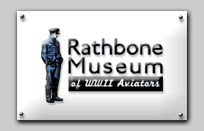 |
|
|
|
 |
|
 |
 |
 |
|
 |
 |
 |
|
|
|
 |
|
|
| Early war Fliegerbluse Uniform for a Hauptmann (all items courtesy of Gene Ashton, Collector) |
|
|
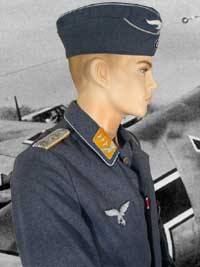 |
|
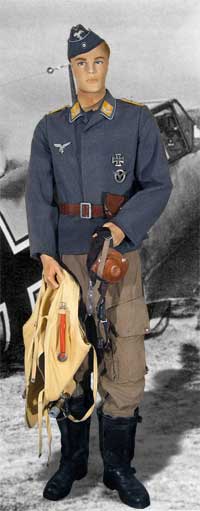 |
|
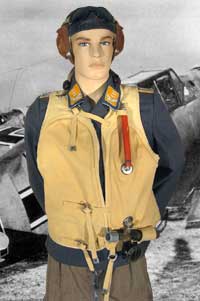 |
|
|
| This young Hauptmann (Captain) is standing in front of his Me109-E. He is wearing a 1935 dated Fliegerbluse (Flyer's blouse) of enlisted wool quality and without slash pockets.His hat is very interesting. The style of of his cap is cut like a Heer, or Army version, with scalloped sides. The insignia on the cap is enlisted eagle and cockade, but the material is officer quality gabardine. |
|
|
| His Schwimmweste is the very rare Model 10-30 full back inflatable life preserver. |
|
| <<His Kanalhosen are summer weight and his boots are typical non-electrically heated model. His belt is a private purchase Sam Browne style and the holster is for a small automatic pistol. |
|
|
|
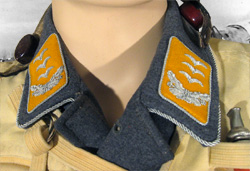 |
|
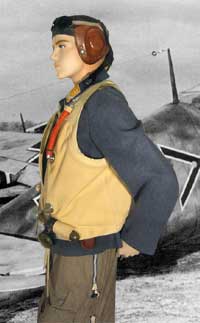 |
|
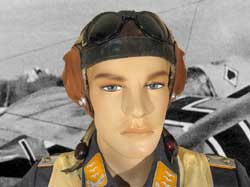 |
|
|
| The collar of the Fliegerbluse was typically worn open and was the working dress of choice for active flight duties. The brown, bakelite tabs are microphones that would be snapped around the throat during flight. |
|
|
|
The flight helmet is the LKpN101 model and the goggles are Nitsche & Guenther shatterproof model with hinged nosepiece, allowing the lenses to swivel. |
|
|
|
|
*Click on any picture to see full size. |
|
|
|
A side view of the Hauptmann showing the bright orange manual inflation tube. |
|
|
|
|
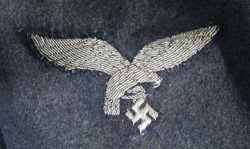 |
|
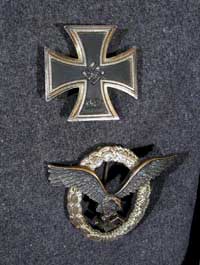 |
|
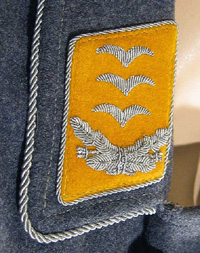 |
|
|
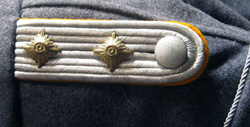 |
|
|
He has won the Iron Cross 1st Class, institued after hostilities broke out in September, 1939, for bravery. The pilot badge is an early (pre-war) nickel silver piece made by the company of Berg & Nolte in Luedenscheid, Germany. |
|
A close up view of the collar tabs shows the half oak wreath of a junior officer and the three gulls of a Hauptmann. The silver cord around the collar is for officers. |
|
|
| The Luftwaffe eagle is an early high-qulity bullion model with a drooped tail. The shoulder boards are solid silver tress with two gilt pips for Hauptmann. The yellow color signified flying and parachute personnel. |
|
|
*Click on any picture to see full size. |
|
|
|
|
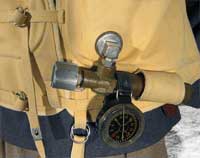 |
|
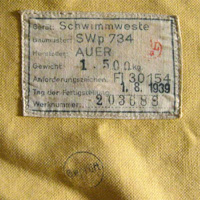 |
|
|
|
*Click on any picture to see full size. |
|
|
| A close-up view of the self-inflating mechanism of the preserver. If it failed, the pilot would manually inflate it by breathing in to the orange tubes. The pilot's wrist compass is wrapped around the valve. |
|
|
| The manufacturer's tag of the very rare Model 10-30 full back inflatable life preserver, dated 1939. |
|
|
|
|
|
|
|
| © 2004 Tod Rathbone |
|
|
|
|
|
|
|
|
|
|
|
|
|
|
|
|
|
|
|
|
|
|
|
|
|
|
|
|
|
|
|
|
|
|
|
|
|




















